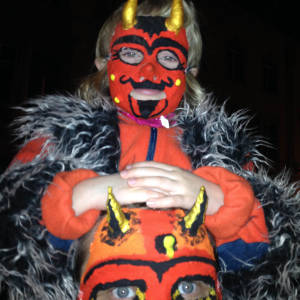Droste effect
The Droste effect — known as mise en abyme in art — is the effect of a picture appearing within itself, in a place where a similar picture would realistically be expected to appear.[1] The appearance is recursive: the smaller version contains an even smaller version of the picture, and so on. Only in theory could this go on forever; practically, it continues only as long as the resolution of the picture allows, which is relatively short, since each iteration geometrically reduces the picture's size. It is a visual example of a strange loop, a self-referential system of instancing which is the cornerstone of fractal geometry.
The effect is named after the image on the tins and boxes of Droste cocoa powder, one of the main Dutch brands, which displayed a nurse carrying a serving tray with a cup of hot chocolate and a box with the same image.[2] This image, introduced in 1904 and maintained for decades with slight variations, became a household notion. Reportedly, poet and columnist Nico Scheepmaker introduced wider usage of the term in the late 1970s.[3]
The Droste effect was used by Giotto di Bondone in 1320, in his Stefaneschi Triptych. The polyptych altarpiece portrays in its center panel Cardinal Giacomo Gaetani Stefaneschi offering the triptych itself to St. Peter.[4] There are also several examples from medieval times of books featuring images containing the book itself or window panels in churches depicting miniature copies of the window panel itself. [5]
Examples[edit]
In the 1971 science fiction film Escape from the Planet of the Apes, the character Dr. Otto Hasslein (Eric Braeden) attempts to explain the appearance in present day of intelligent apes from Earth's future. Hasslein uses a painting on a CRT monitor to illustrate an effect he refers to as "infinite regression." The demonstration consists of a camera pulling away from a picture of an artist painting a picture, on a suggested infinite loop.
- 3
- 0
- Canon PowerShot SX280 HS
- 1/50
- f/4.0
- 5mm
- 800

Comments
Sign in or get an account to comment.


